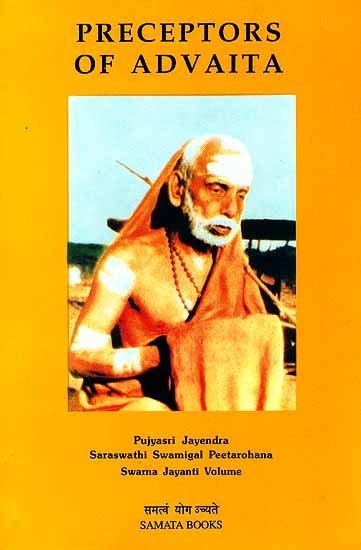Preceptors of Advaita
by T. M. P. Mahadevan | 1968 | 179,170 words | ISBN-13: 9788185208510
The Advaita tradition traces its inspiration to God Himself — as Śrīman-Nārāyaṇa or as Sadā-Śiva. The supreme Lord revealed the wisdom of Advaita to Brahma, the Creator, who in turn imparted it to Vasiṣṭha....
57. Śrī Śaṅkara And Śaṅkarite Insitutions
SRI SANKARA AND SANKARITE INSTITUTIONS
by
Swami Anantanandendra Sarasvati
śruti-smṛti-purāṇānām ālayam karuṇālayam
namāmi bhagavatpādam śaṅkaram lokaśaṅkaram.
Great credit is due to Śaṅkara and his school for having fought strenuously against the upholders of self-existence of the material world and brought the whole universe under the sway of God to whom it owes not only its organisation but also its very being. Śaṅkara understood that the independent existence of another being would imply limitation of God.[1]
Or let us, more truthfully, say that in honouring the memory and work of Śrī Śaṅkarāchārya we are just honouring ourselves.[2]
Devotional offerings to Śrī Śaṅkara and receiving blessings from His Living Representatives in His various Pīṭhas during auspicious occasions such as Śaṅkara Jayanti, Vyāsapūjā, Vijaya-daśami, etc., would go a great way in spiritually elevating us. Some of the institutions directly established by him thrive even to-day under Aciharyas glowing with spiritual lustre, while some are vacant and some have ceased to exist. However to remember all the holy places where Śrī Bhagavatpāda started institutions is a spiritual asset for the devotees. Besides the institutions about which we can get some evidence of their being established directly by the great Āchārya, many institutions have sprung up from the original roots and thrive with vigour in serving Hinduism.
Traditional evidence recorded by eminent personages may give us a glimpse of such institutions so that we may not only contribute our humble mite towards the upkeep and renovation of such institutions but also benefit ourselves spiritually.
1. Guruvaṃśa-Kāvya[3] of Śṛṅgeri written under the direction of Śrī Sachchidānanda Bhāratī Swāmi, Head of the Śṛṅgeri Maṭha (1770-1814), says that Śrī Śaṅkara established five mutts at Benares, four for his disciples and one for Himself. The author has himself written a commentary on this work.
vāraṇasīm yogivaro’dhigamya bhujairiva śrīharireṣa śiṣyaiḥ
sahātmanā pañcha maṭhānamīṣām prakalpya tasthau katichiddināni.
(Sarga 3; Verse 23).
In the commentary it is said:
ātmanā saha amīṣām śiṣyāṇām pañcha maṭhān prakalpya,
2. The following extract from the Annual Report of the Archaelogical Department’ of Mysore for the year 1928 written by the Director of Archaeological researches in Mysore and published under the auspices of the University of Mysore contains reference to the Guruvaṃśa-mahā-kāvya at p. 15.
Guruvaṃśa-Mahā-Kāvya: History of Teachers of Śṛṅgeri Maṭha: Author. Lakṣmaṇa Śāstrī, son of Viśveśvara Śāstrī, under the orders of Śrī Sachchidānanda Bhāratī, disciple of Śrī Narasimha Bhāratī. The author is contemporary of Soma Śekhara II (1714-1739) of Keladi when Sachchidānanda Bhāratī (1705-1741) adorned the pontifical seat at Śṛṅgeri. . . . . . . . . . . . . . . . It may be reasonably presumed that he faithfully copied all traditional informations about the successive teachers of Śṛṅgeri. . . . . . . . . . . The author says that He set up Five Maṭhs and mentions the names of Śṛṅgeri, Kāñchī, Badari, Kāśī and Jagannāth.
From this extract, it may be presumed that the text of Guruvaṃśa-kāvya and its commentary to which the Director had access mentions clearly the names of the Maṭhas which the Āchārya probably planned while staying at Benares.
3. The Cochin State Manual gives the information that some Maṭhas tracing their origin to the direct disciples of Śrī Śaṅkarāchārya such as Sureśvara and Padmapāda with Nambudiri Sannyāsins as their heads are found in Trichur in Kerala. Outside Trichur there is a Nambudiri Sannyāsi Maḍam called Tirukkekkat Maḍam which is also said to have been situated originally at Trichur. One of them is called Nadu vile (Central) Maḍam. One of these has been converted as Brahmasva Maḍam, i.e., Vedic Centre for Nambudiri Brahmins. Professor K. Rama Piṣaroti, M.A., in an article on The Age of Śaṅkara in the Light of Kerala Legends published in The Hindu, dated July 4, 1932, states that these Maṭhas might not have been established at the time of Śrī Śaṅkara, that it was likely that even before Śrī Śaṅkara’s time, these places were traditional centres of Vedic learning, and that Śrī Śaṅkara converted them as his Maṭhas. But he confirms the tradition that the direct disciples of Śrī Śaṅkara were the first presidents of these Maṭhas. This opinion that Śrī Śaṅkara converted such institutions of saintly scholars which existed before his time as monasteries to foster his Advaita philosophy finds an echo in a work called Kāñchī-māhātmyam,[4] which states that Devī Kāmākṣī, the presiding deity of Kāmakoṭi Pīṭha was worshipped by the Yatis:
upāsate manasyevam bhūmau kāñchyām yatīśvarāḥ
[Kāñchīmāhātmyam, Chapter 31.]
4. The Chengleput Gazetteer, published by Charles Stuart Crole Esq., I.E.S., in the year 1879, says that Śrī Śaṅkarāchāriar paid particular attention to Kāñchīpura, where He worked many miracles and founded a Mutt or a monastery.[5]
Note—(a) This Maṭha has all along been maintained mainly by payments of certain portion of the produce from the cultivable lands in the country. This payment which went under the name of “Merai” in some Taluqs round about Kāñchī was recognised by the High Court which says:
“We think the evidence justifies the inference that this payment of the disputed merai hau a lawful origin and was not merely voluntary.”[6]
(b) The Collector of Tanj ore recommends that the allowance of Rs. 6743-5-0 due to Śrī Śaṅkarāchāriar’s Maṭha at Kumbakonam which is now paid in the shape of an assignment of land revenue be disbursed hereafter direct from the Sub-Treasury at that station. . . . . . . . . . . . In any case the Government considers that the method of payment by beriz deduction is much to be preferred and accordingly directs that the land revenue assignment be resumed and that the allowance of Rs. 6743-5-0 be paid in future by beriz deduction.[7]
5. There is an inscription dated Vikrama Saṃvat 1941, Śālīvāhana Śaka 1806 (1884 A.D.) in the Brahmendra Mutt, Śivālaya Ghāt, Benares, which refers to
Jagadguru Śaṅkarasya pāraṃparyakramāgata-śiṣya sanmārganiṣṇata Chandraśekharanāmā. . . . indramaṭābhidham
indicating thereby that a paraṃparā of Śrī Śaṅkarāchārya with Indrapaṭṭa existed in the last century at Benares.
jagadguroḥ śaṅkarasya pāraṃparyakramāgataḥ
śiṣyah sanmārganiṣṇātaḥ chandraśekharanāmakaḥ
tasya śiṣyo viśvanātha yatīndro yoginām varaḥ
kāśyām śivālaye ghaṭṭe kāśīrājagurormaṭhe
svakīye nivasan svīyam anyam maṭham udāradhīḥ
babandha grāvabhir-mūlāt divyam indramaṭhābhidham.
6. In Benares itself there is a Maṭha known as the Sumeru Maṭha otherwise called Pādukā Maṭha, under the royal patronage of His Highness the Mahārājā of Benares. It is now presided over by a Bengali daṇḍi-sannyāsin. In an appeal issued on behalf of this Maṭha for funds for repairs, the following statement appears under the signatures of the persons in the list given below:
“During his stay at the holy city of Kāśi (Benares), Paramahaṃsa Parivrājakāchārya Jagadguru the Ādi Śaṅkarāchārya Maharāj established the Sumeru Maṭha”. . . . . . . . . .
List of the Signatories in the Appeal issued on behalf of the Sumeru Maṭha:—
- Srimat Svami Ramesvarananda Tirth Dandi, ‘Omkar Math’, Benares.
- Srimat Dattatreyananda Sarasvati, Guru Dattatreya Math, Benares.
- Srimat Sivanath Puriji, Mahant Maharaj, Sri Sri Annapurna Mandir, Benares.
- Srimat Mahabir Prasad Maharajji, Proprietor, Sri Sri Bisvesvar Mandir, Benares.
- Mahamahopadhyaya Pandit Pramathanatha Tarkabhuṣan.
- Mahamahopadhyaya Srijut Pandit Ananda-Charan Tarka Chudamani.
- Mahamahopadhyaya Srijut Pandit Vama Charan, Nyayacharya.
- Mahamahopadhyaya Srijut Pandit Padmanath, Vidyavinode, MA.
- Sjt. Pandit Ṣyama Kanta Tarka Panchanana (Kashi Naresh Sabha Pandit).
- Sjt. Pandit Gopi Chandra Sankhya Thirtha, Professor, Brahmana Sabha, Benares.
- Aghoranath Vidyabhuṣan, Late Professor, Metropolitan Institution.
- Vedacharya Pandit Upendra Mohan Chowdhury. Kavibhuṣan Vedasastri Vidyavinode, B.A., Secretary Mahakali Duhitri Sikṣa Pariṣat, Pracharak, Ranchi Brahmacharya Vidyalaya.
- Raja Sjt. Jagat Kishore Acharya Chowdhury, Muktagacha.
- Kumar Sjt. Hemendra Kumar Roy, Dighapatia.
- Rai Sjt. Lalit Behary Sen, Rai Bahadur, private Secretary to H. H. the Maharaja of Benares.
- Captain S. K. Chowdry, B.A., M.B., Late I.M.S., Chief Medical Officer, Benares State.
- Sjt. Bhim Chandra Chatterjee, B.A., B.L., B.Sc., A.M.I.E.E., Head of the Department of Electrical Engineering, Benares Hindu University.
- Sjt. Kishori Mohan Sikdar, Zamindar, Retired Sub-Judge.
- Sjt. Mahendra Lall Banerjee, Zamindar, Chittagong.
- Sjt. Bankim Chandra Chatterjee, Superintendent, Sri Bharat Dharma Mahamandal, Benares.
- Sjt. Kripa Nath Banerjee, Superintendent, Sri Sri Annapurna Mandir, Benares.
- Sjt. Satish Chandra Dey, B.A., LL.B.
- Sjt. Jagadish Chandra Roy, Associated Press of India.
- Sjt. Dwijendra Nath Dhar, F.R.C.S. (London).
7. Light of the East (Vol. 11, No. 11, July 1894), when saying that Śrī Śaṅkara established several Mutts while touring over India, states that He founded a Mutt at Gangotri on the slopes of the Himalayas besides the Joshi Mutt.
8. The late Ganganath Jha, Ex-Vice-Chancellor, University of Allahabad, says: The establishment of seats of worship at places like Kāñchī, Śṛṅgeri, etc., where His successors carry on the worship of the deities even today in all its fullness is a further proof of the view held by the Āchārya that due performance of rites is an integral feature of His teachings.[8]
9. The late Sri S. S. Suryanarayana Sastri says in his book Śrī Śaṅkarāchārya that Śrī Śaṅkara established several mutts, the most notable of which are perhaps those of the Śāradā Pīṭha and the Kāmakoṭi Pīṭha and finally departed from this world at the early age of thirty-two.[9]
10. The late Dr. Sir C. P. Ramaswami Iyer in his brochure, World Religions—A Study in Synthesis, says that Śaṅkara established mutts or centres of religious learning and practices in the North, South, East and West of India, and that Śrīnagar, Dwāraka , Purī, Śṛṅgeri and Kāñchī were his far-flung spiritual capitals.
11. A History of South India published by the Oxford University Press, Madras, 1955, states that Śrī Śaṅkara founded a number of Maṭhas in different parts of India, the best known being those at Śṛṅgeri, Dwāraka, Badrinath, Purī and Kāñchī.
12. The Bulletin of the Institute of Traditional Cultures, (UNESCO) 1957, published by the University of Madras, referring to the Śṛṅgeri Mutt, says “One of the five maṭhas established by Śaṅkarāchārya of the 8th Century A.D.”
13. Dr. T. M. P. Mahadevan, Professor of Philosophy, University of Madras says: He (Śrī Śaṅkara) set up at cardinal points of the country monastic institutions which would safeguard the spiritual interests of the race. Of these institutions five are the most important. Except the one at Badari in the Himalayas, the other four were in the peninsular part of India, at Purī, Dwāraka, Śṛṅgeri and Kāñchī.[10]
14. Śrī Jagadguru Aṅka of Prabhāth, Mangalore, 1958, says that the Āchārya established mutts at Śṛṅgeri, Dwāraka, Badrikāśrama, Purī, Kāñchī, etc. (p. 4).
15. The Thīrthāṅka of the Magazine Kalyan for the year 1957, published by the Gita Press, Gorakhpur, mentions at page 547 under the heading —Jagadguru Śaṅkarāchārya kā pīṭha aur upapīṭha, and sub-heading — Śrī Śaṅkarāchārya-dvārā-sthāpita-pañcha-pradhān-pīṭha, that Jyotir-pīṭha, Govardana-pīṭha, Śāradā-pīṭha, Śṛṅgeri-pīṭha, and Kāmakoṭi-pīṭha are the five important pīṭhas established by Śrī Śaṅkarāchārya. Besides these it mentions fifteen more maṭhas:
(1) Kūdali Maṭha
Kūḍali is at the confluence of the river Tuṅga and the river Bhadrā in the district of Shimoga in Mysore state.
Note: That this Maṭha was an independent Maṭha and that it was entitled to use Addapallaki and other paraphernalia was held in Appeal No. 22 of 1847 on the file of the Court of Huzur Adalat, Mysore. This order was confirmed by the Commissioner, Mysore, in his order dated 1st June, 1849.
The judgement also quoted that the Paravana of the Phalguna Bahula, 6 of the year Krodhana, is to the effect that the Kūḍali Svāmi should always be on tour and that the Śṛṅgeri Svāmi should ever remain at Śṛṅgeri worshipping the deity.[11]
Mr. B. Suryanarayana Rao, B.A., M.R.A.S., in his “History of Sivaganga Mutt, 1914, states that after the defeat of Maṇḍanamiśra, Sarasavāṇi who was coming with Śaṅkarāchārya was inclined to stay at Kūḍali, which is at the confluence of the rivers the Tuṅgā and the Bhadrā and that He installed her there (p. 30). Śārīraka-mīmāṃsā-bhāṣya printed in and published by the Venkatesvara Press, Bombay, in the year 1931 in its Bhūmikā written by Mahavidvan Venkaṭāchala Śarma, son of Paṇḍita Dharmādhikāri Śrī Venkaṭasubramaṇya Śastri and grandson of Paṇḍita Dharmadhikarī Kāśī Seṣa Nāgesvara Śāstriar of Mysore has the following observations in Sanskrit regarding this Kūḍali Mutt[12]
“anyasmai pustakasannyāsāśramam daduḥ tataḥ keshuchiddivaseṣu vyatīteṣu uktaḥ svāmī (yātrām gataḥ svāmī) deśayātrātaḥ pratinivṛtya kūḍalīmāgatya enam vṛttāntam (mahājanaiḥ śṛṅgerimaṭhīya pīṭhādhipatye sthāpitasyānyasya sannyāsino vṛttāntam) śrutvā rājyasthāne (hujūrais) lekhanasya nivedanāt pakṣadvayamapi teṣāmāhvāpanadvārā vichāritam. tena cha asmābhiḥ tatratyairmahājanaiḥ haṭhena dattaḥ pustakasannyāsaḥ satyaḥ ityavagatam. tathāpi upadeśasannyāsādhikamanena deyam, pustakasannyāsibhistu grāme (śṛṅgeri grāme) eva sthitvā śrī śāradā matṛpūjāṃ kurvadbhih maṭhe niyamaniṣṭhayā sthātavyam śaṅkarāchāryaparaṃparāgataiḥ svāmibhih deśasañchārādikam kurvadbhiḥ, kūḍalyām (lagyām) sthātavyam ” iti.
idam prāchīna lekha-pustaka-rājaśāsana-patrikā-lekhādyanuro-dhena saśiśekhar-dāmodara-saṅkeśvarīya-vidyāśālāyāḥ adhyāpakena likhite “śrī saṃsthānasankeśvar maṭh karavīr va saṅkeśvar chā itihās” iti nāmnā prasiddhe mudritapustake sphaṣṭam . (p. 34).
It may be stated here that the Śivagaṅgā and Āvaṇi Mutts have been paying annually some amounts to the Kūḍali Mutt. This is evident from the letters from Śivagaṅgā Mutt dated Khara, Kārtika Śuddha 15, Śālivāhana Śaka 1633, 1711 A.D. and the letter bearing Vyaya, Śaka, 1635,1713 A.D. and from the letters from Āvaṇi Mutt dated Vyaya, Māgha Śuddha 15, Śālivāhana Era, 1635, 1714 A.D. and Jaya, Ś ālivāhana Śaka 1636, 1715 A.D.
(2) Śivagaṅgā Maṭha.
(3) Āvaṇi Maṭha (Kolar District, Mysore).
(a) The present occupant of the Āvaṇi Maṭha in his letter dated 18-9-1961 from his camp at Thathahalli to Gurubhaktamani A. Ramaswami Ayyar, Mallesvaram, gives the following details about the origin of this Āvaṇi Maṭha.
About 500 to 600 years ago, one of the direct successors of Śrī Ādi Śaṅkarāchārya, probably the tenth in the line of the Śṛṅgeri Maṭha established at Śriṅgeri, as was the custom, went on tour and pilgrimage of northern parts of the country and visited Kāśī and other places. Due to lack of proper communication it took a long time to return to the head-quarters. By the time he returned, the authorities at Śṛṅgeri thinking that the āchārya might not return at all gave pustaka-sannyāsa to a brahmin and installed him on the gadi. The former one came to know of this as he neared Śṛṅgeri; and, he sent word about his return. But the authorities there did not receive him because of the fear of dethroning the one they themselves had established in his place. Though the former āchārya had every right to claim for the recognition of the position he was still occupying, he did not do so, as he thought that it would not be in keeping with his position as a sannyāsin to fight for the mundane position. He, therefore, settled down at Kūḍali.[13] After some time he went on tour to Rāmesvaram and other kṣetras in southern parts. This time he did not want that the incident which took place when he had been to Kāśī and other kṣetras should recur. Moreover, it was not possible for one to get back to headquarters early due to vastness of the country and lack of adequate means of communication. Hence he appointed one of his disciples at Kūḍali ordering him to tour the parts surrounding it and he went on tour to Rāmesvaram and other kṣetras of the south. Visiting Rāmeśvaram and other kṣetras he came to Kolar (then Kolaharapuri) via Kāñchī, Kālahasti, Tirupati and other places. Finding the piece at Antargaṅgā on the Śataśṛṅganarvata at Kolar a congenial place for performing meditative worship, he established a maṭha there. Thus an institution came into being there. After a couple of centuries, due to political reasons at the time of Mohammedan rule, this Maṭha moved to Avanti kṣetra, now called Āvani from the time of Britishers’ rule at Mysore, where the sage Vālmīki had his āśrama and where Sītādevī gave birth to Lava and Kuśa. Since then the institution continues to have its head-quarters at Āvaṇi. And, as the Maṭha has its head-quarters at Āvani or Avanti for the last few centuries, the Maṭha also came to be called Avaṇi Maṭha although it was originally established at Śṛṅgeri by Ādi Śaṅkarāchārya.
(b) The āchārya of this Maṭha in the 18th century was on tour in the Southern districts of Madras State. While travelling in the Trichy district, the Maṭha collected agrasaṃbhāvanā, etc., from the residents of the villages on the banks of the Akhanda Kāveri. When it was brought to the notice of the Maṭha that this was not proper, the Maṭha returned the agrasaṃbhāvanā thus collected to the Kāmakoṭi pīṭha. The Maṭha wrote a letter to the Kāmakoṭi pītha stating that it was going on pilgrimage to Rāmeśvaram, and it would be passing through Rāmnād, Śivagaṅgā and other places. The letter further stated that the Maṭha would not collect agra-saṃbhāvanā In these places, and after visiting Rāmeśvaram, Tirunelveli and Anantaśayanam, it would return to it's place.
(4) Virūpākṣa Maṭha (Hospet Taluk, Bellary District).
(5) Puṣpagiri Maṭha (Cuddapah Taluk, Cuddapah District).
One Kokkondrum veṅkaṭaratnam Pantulu in his work Śāṅkara-maṭhatattvaprakāśikārthasaṅgraha written in favour of the Śṛṅgeri Maṭha quotes from a work called Puṣpagiri-maṭhāmnāya-stotra the following verses which mention the circumstances and give the dates for the establishment of the Virūpākṣa and the Puṣpagiri Maṭha.[14]
tataḥparam gajādrīndu rūpake śakavatsare
vidyāraṇyaguruḥ kāñchīnagaryām sa babhau mahān
paṃpākṣetre vasanmaunī bhaktarakṣaṇatatparah
mūkam vāphālamakarot mūḍham paṇḍitamuttamam
daridram dhaniṇām śreṣṭham vandhyam putravatīm tathā
yasyānghṛdhyānamātreṇa dvijāssyuh vedapāragāḥ
tam vandeham sadā bhaktyā vidyāraṇyagurūttamam
tasya siṣyau mahāprājñau Chandraśekhara bhāratī
nṛsiṃhabhāratī chaiva dvāvimau lokapūjitau
tuṅgaśṛṅgagirau pīṭhe chandraśekharabhāratīm
viniveśya tatassarvam vidyāraṇyaguruḥ svayam
puṇyakṣetre virūpākṣe maṭhamekam manoharam
prakalpya tatra sachchiṣyam narasiṃhendrabhāratīm
nivāsayāmāsa tataḥ śubhakṛtvatsarottame
vaiśākha kṛṣṇapakṣasya tṛtīyāyām vidhordine
visṛjya kāñchhīagaramn sahaiśvaryam savāhanam
vidyāraṇyaguruḥ svāmī kailāsālayam aviśat
tadārabhyābhavat pīṭhadvayam vandhyam budhaiḥ sadā
virūpākṣamahāpīṭhe nṛsiṃhendraguroḥ param
surendrānandanāthaścha tataśśaṅkarabhāratī
nṛsiṃha bhāratīṅdraścha tataśchidghanabhāratī
tatahparam śaṅkarendro vidyāraṇyasarasvatī
nṛsiṃhabhāratī chātha punaśśaṅkara bhāratī
sachchhiṣyassachchidānandaḥ śrī vidyāraṇyabhāratī
tato vidyāśaṅkarākhyaḥ sachchidānandabhāratī
tataḥ sadānandaguruḥ śrīmachchhaṅkarabhāratī
tasya śiṣyo bhavat vidyānṛsiṃhendra sarasvatī
śiṣyaprārthanayā lokam paryaṭan karuṇākaraḥ
devatāyatano’petam puṇyakṣetram budhaiḥ stutam
śrīpuṣpaśailamāgatya nadītīramupāśritaḥ
taponiṣthagariṣṭhānām idam yogyasthalam bhuvi
ityālochya nṛsiṃhendro navabāhuguṇendunā
prakāśite śakapatau kalpayitvottamam maṭham
sarvajitvatsare prāpte vaiśākhe sitapakṣake
saptamyām bhārgave vāre śubhalagne surārchite
sthānādiṣaḍbalayute nṛsiṃhendrasarasvatī.
pīṭhe śrīpuṣpaśailākhye praviṣṭobhūnmahātapāḥ
virūpākṣasya pīṭhasya śaṅkarendrasarasvatīm
samastajagatām pūjyam śiṣyamevamakārayat
tatpuṣpagiri pīṭheśa nṛsiṃhendra sarasvateḥ.
(6) śaṅkeśvara Karavīra Maṭha —one at Poona, the other at Saṅkeśvara, the third at Kolhapur and the fourth at Satara.
(7) Rāmachandrapura Maṭha (Rāmachandrapura, Hosanagara Taluk, Mysore State).
(8) Hariharapura Maṭha (near Śṛṅgeri).
(9) Bandigadi Maṭha.
(10) Yadanīru Maṭha (Kasargode Taluk, South Canara District).
(11) Kodaṇḍarāma Maṭha (Hebbairu Village, Tumkur Taluk, Mysore State).
(12) Svarṇavalli Maṭha (Sirsi Taluk, North Canara District).
(13) Nelamabu(?) Maṭha (North Canara).
(14) Yoga Narasiṃhasvāmi Maṭha (Hole-Narasipur, Mysore State).
(15) Balakuduru Maṭha (Udipi Taluk, South Canara District).
16. Besides the pithas and maṭhas mentioned above, the bhūmikā written by Mahāvidvān Venkaṭachala Śarmā referred to already gives the names of many maṭhas describing them as Śrī Śaṅkarāchāryādividyā-dharma-pīṭhādhipa-paraṃparāgatamaṭhāḥ:
- Sumeru Maṭha,
- Paramātma Maṭha,
- Sumeru Maṭha at Kāśī,
- Havyaka Maṭha,
- Koppala Maṭha,
- Śrī Śalam Maṭha,
- Rāmeśvaram Maṭha,
- Ghanagiri Maṭha,
- Honnahalli Maṭha,
- Kaivalyapura Maṭha,
- Mulabagalu Maṭha,
- Sirali Maṭha,
- Gṛdhrapura Maṭha,
- Nṛsimhavādi Maṭha,
- Molavana Maṭha,
- Paitana Maṭha,
- Kāśī Maṭha,
- Tīrtharājapura Maṭha,
- Gangotrī Maṭha,
- and Tīrthahalli Maṭha.
Among these there is a maṭha called Rāmeśvara Maṭha. This may, perhaps, explain the fact that Śrī Śaṅkara established maṭhas at the four corners, chār-dhāms, of India, Rāmeśvaram being situated at the southern corner of India, just as Dvāraka, Badrinath, and Jagannatha in the western, northern and eastern regious of the country.
Sarasvatī or Śāradā Devī who was following Śaṅkarāchārya after her husband’s defeat stopped on the banks of the Tuṅgabhadrā on the north-western part of South India. In consequence of her stopping there, a Śaṅkarite Institution might have come into being there (not the southern cardinal point) for the up-keep of Her Pūjā.
It may be stated here that almost all the Āmnāyas, including the Āmnāya found in the Unpublished Upaniṣads published in Adyar, the Jagadguru Aṅka of Prabhāt, Mangalore, 1958, and the Yati-sandhyā published by the Dvārakā Pīṭha, mention Rāmeś-varam as the kṣetra of the southern region. Almost all these Āmnāya versions mention Ādivarāha (Kāñchī) as the devatā of the southern region. While enumerating the one hundred and eight vaiṣṇava-divya-deśas, Ādivarāha is found to be situated in the Kāñchī Kāmākṣī temple.[15] The three places, one on the banks of the Tuṅgabhadrā, and the other two at Kāñchī, and Rāmeśvaram, are specially sacred as being respectively the stopping place of Śāradā Devī, the abode of Ādivarāha inside the Kāmākṣī temple, and the kṣetra of the southern region.
According to the Āmnāya text of the Dvārakā Maṭha, Śrī Viśvarūpāchārya (Sureśvarāchārya) was anointed in DvārakĀ and Śrī Pṛthvīdharāchārya in Śṛṅgeri. According to the same Āmnāya, the maṭha at Dvārakā is designated as Śāradā maṭha or Śāradā Pīṭha. According to the Āmnāya text of the Śṛṅgeri Maṭha, Śrī Sureśvarāchārya was anointed in the Śṛṅgeri Maṭha and this Maṭha is designated as Śāradā Pīṭha.
Kāñchī is the spiritual centre of the earth; and, this is clear from the following śloka in the Kāñchī Māhātmyam:
kañchīpuram samālokya nananda kamalā muhuḥ
ādhibhautikam aṃhoghnam nābhisthānam bhuvaḥ paraṃ
(Adhyāya, 31)
The Sthala-purāṇa Kāmākṣī-vilāsa states that Kāñchī is the girdle of the earth (I, 56). And the work Śaṅkarābhyudaya states: atha kṣiteradbhutakāñchīmaikṣata. Historically, even at the time of Śrī Śaṅkarāchārya, Vedic Culture (Hinduism) extended from Central Asia to Indonesia; and, Kāñchī would thus have been the centre of the Hindu world.
In the various Āmnayās, Ūrdhvāmnāya mentions Śukadeva as one of the Brahma-niṣthas or Brahmacharis of that Āmnāya and Kāśī or Kāśikā as the Saṃpradāya. There is one Maṭha called Śukadeva Maṭha in Kāśī or Vārāṇasī. It is not dear whether this Māṭha has any connection with that Āmnāya.
Further, this bhūmikā gives under the heading— Maṭhīya-śrīmukha-birudāvalī, the Śrīmukhams and Birudas of some of the maṭhas; and, they are as follows:
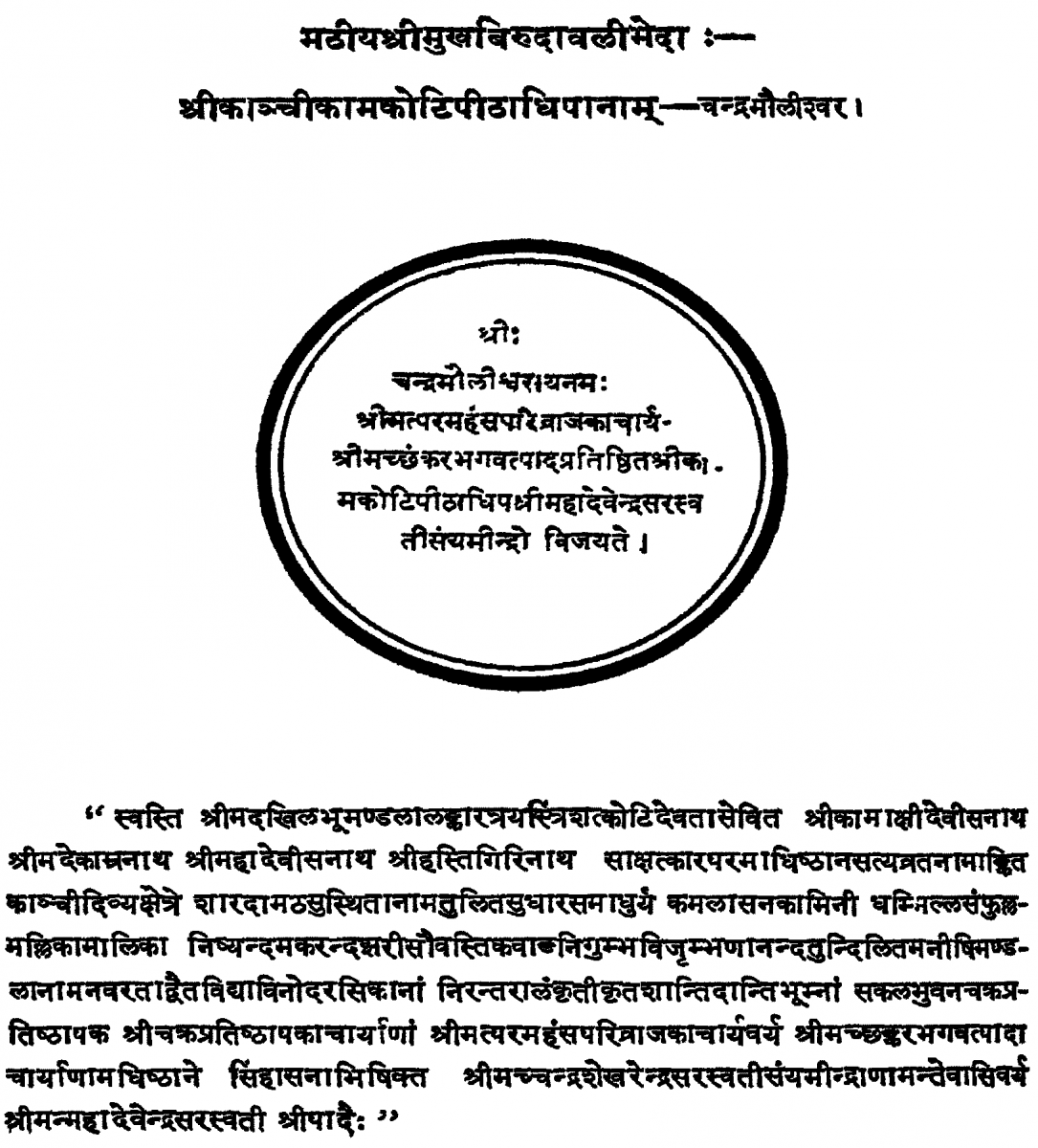
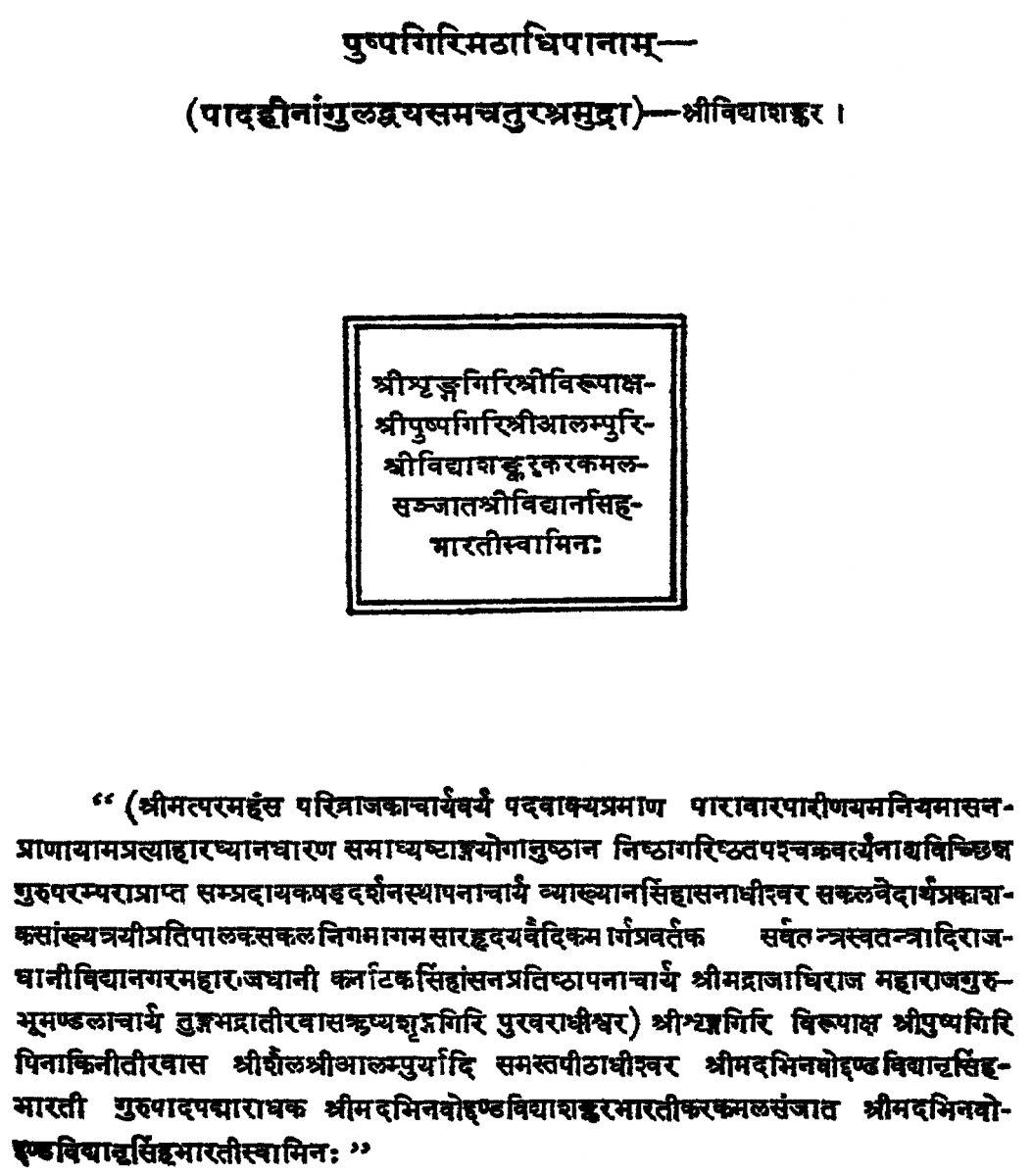
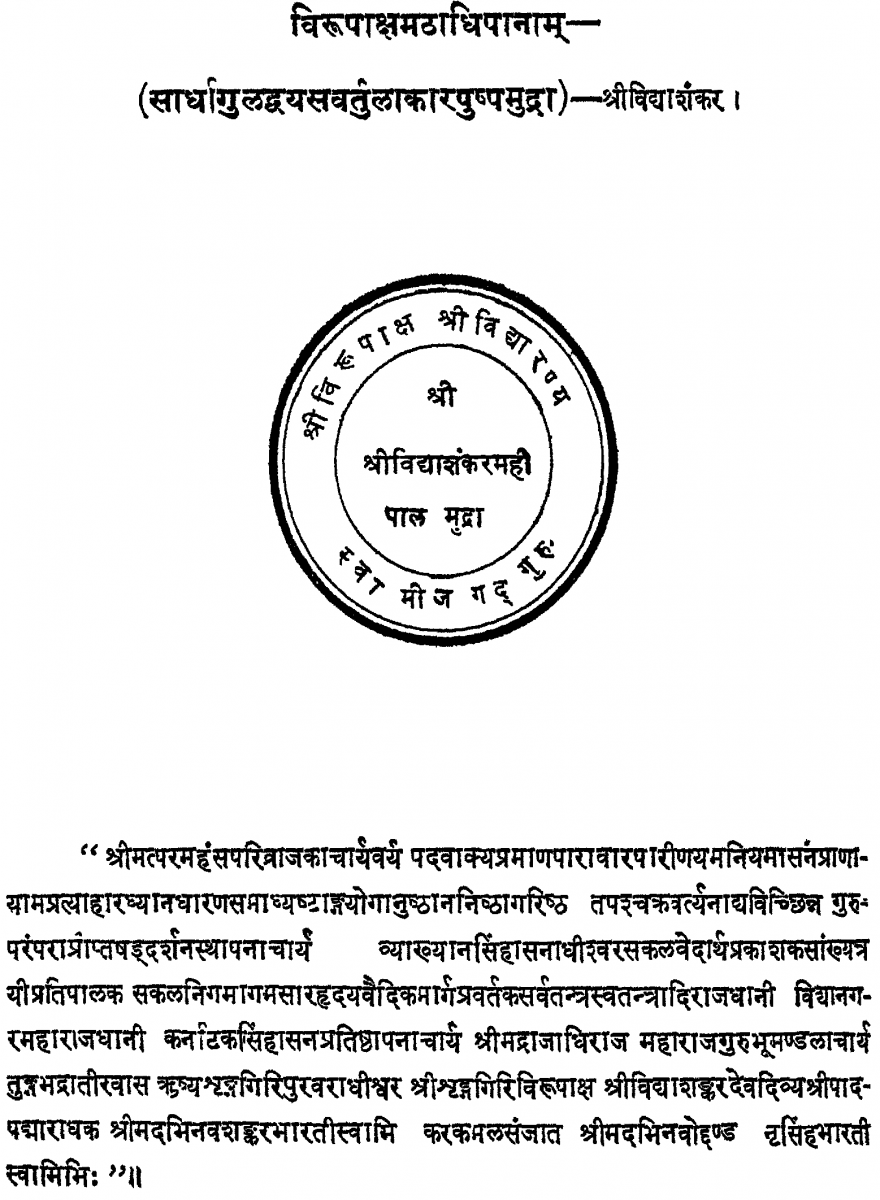
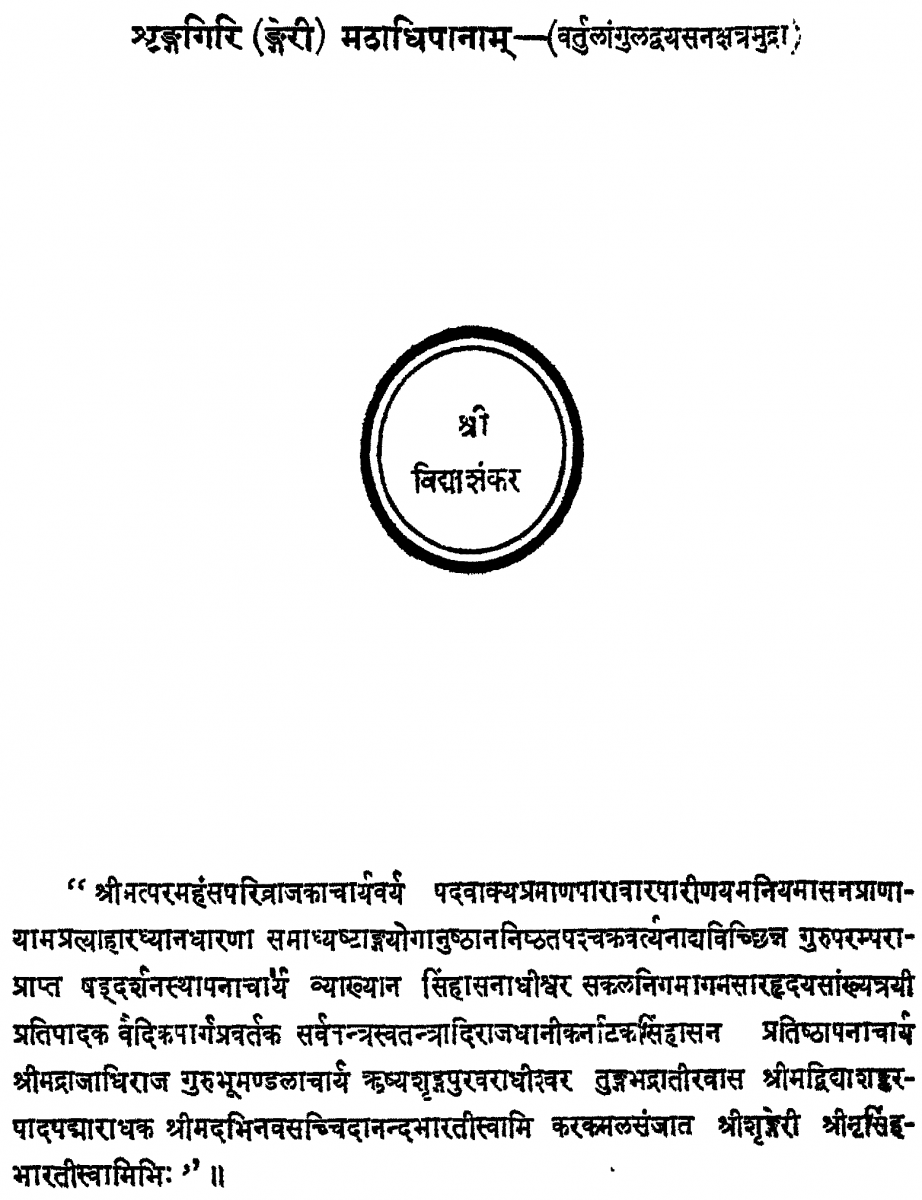
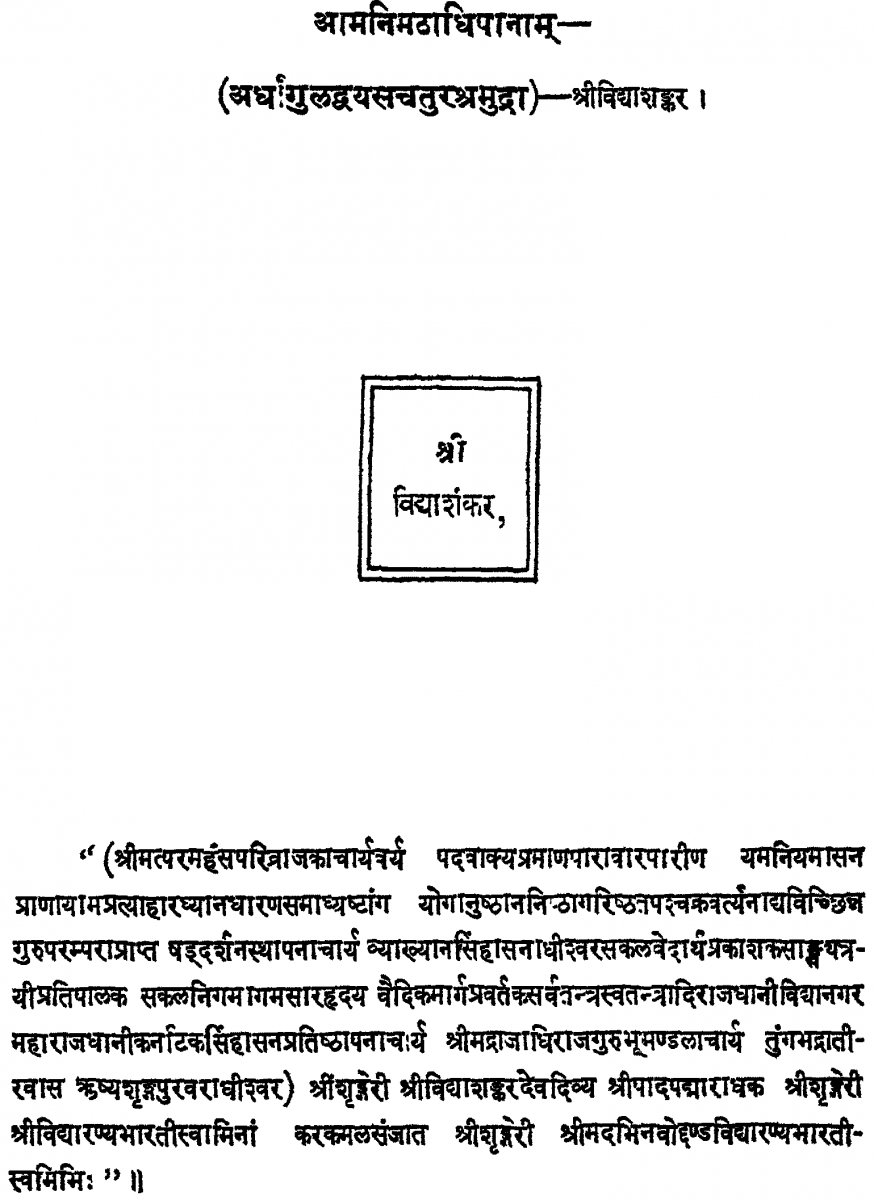
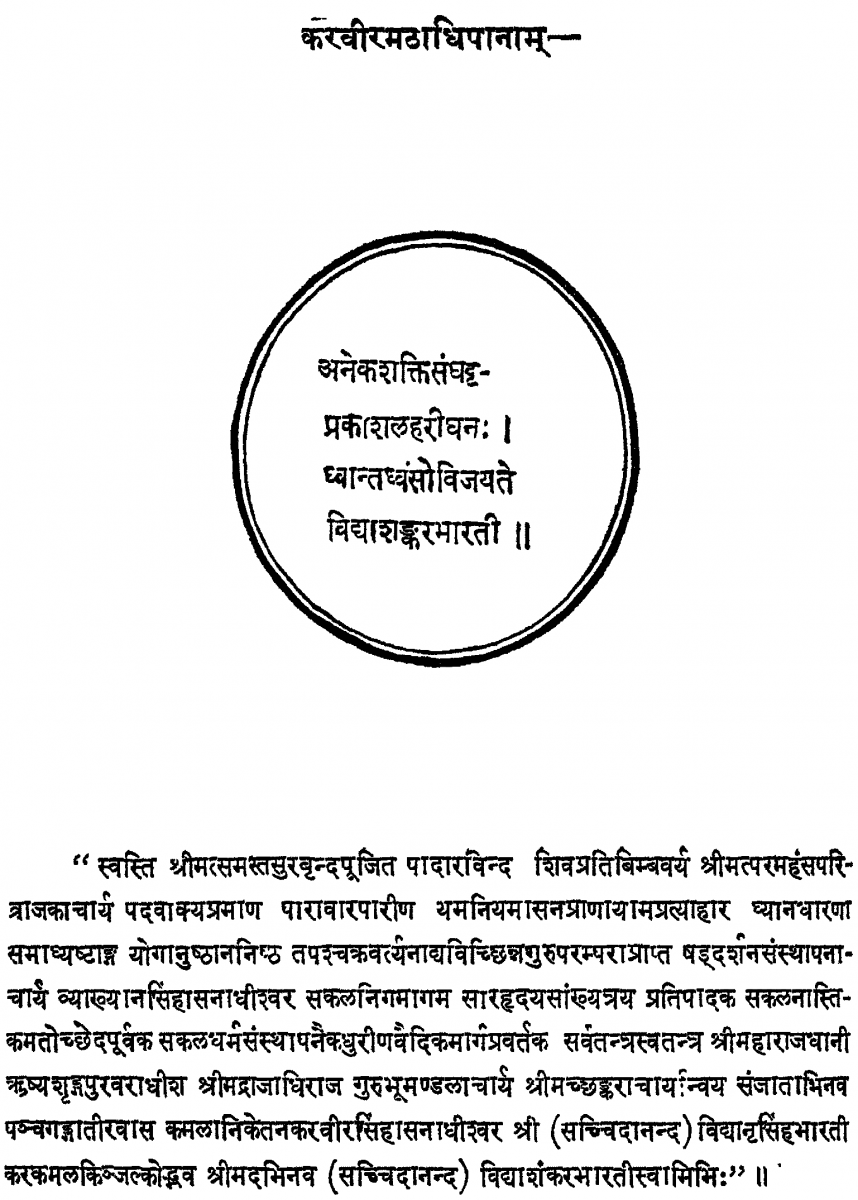
17. Śrī Nūraṇi S. Anantakrishna Sastri, in the Bhakti-kusumāñjali printed at Śrī Vani Vilas Press, Srirangam and published on the occasion of the Nakṣatra Mahotsava of Śrī Chandraśekhara Bhāratī of Śṛṅgeri observes:
‘sahasrāṇi sahasraśo ye rudrā adhibhūmyām’ iti śatarudrīyavākyam śaṅkarabhagavatpādapratiṣṭhāpita-tattatpradhāna-upapīṭhādhyakṣān dharmāchāryāneva gocharayati
ātmano digvijayayātrāprasaṅgena tatra tatra bahūni pīṭhāni bhagavatpādaiḥ pratiṣṭhāpitāni sāṃpratamapi paraṃparākrameṇa kechana kechana tapasvipravarā adhitiṣṭhantyeva. tatra cha bhagavataḥ sadāśivasya pañchānanatā bhagavato guruvaryasya sāntevāsinaḥ śrī dakṣiṇāmūrteḥ sākṣāt bhagavatpūdasya vā sāntevāsinaḥ sthūlaśarīrāṇi prāchya-dakṣiṇa-pāśchātya-udīchya-ūrdhvāmnāyarūpāṇi vā pradhānāni pañchapīṭhāni. idaṃ tu na vivādāspadam—yadukta-anyatama-pīṭhādhiṣṭhānamātreṇa dharmā-chāryāḥ sarve’pi śivāvatāratām svakṛtyairabhivyañjayanti
18.
“It is necessary now to add a few words about the commentary, Chandrikā, which is printed here. . . . The second śloka alludes to the author of the Chandrikā as the glory of Sarvajñāśrama by which term we have probably to understand the Sarvajña-Pīṭha or the pontifical seal of the Advaita Maṭha in Conjivaram.”
[Professor M. Hiriyanna in his Introduction to the Naiṣkarmya-siddhi (Bombay Sanskrit and Prākṛt Series, No. XXXVIII, 1925), p. 33.]
19. The report of the Hindu Religious Endowments Commission, 1962, page 15, says :
“Sankwracharya and Establishment of Mutts.”
It was Adi Sankaracharya (8th century A.D.) who first began to establish Hindu Mutts as we know them today. He propounded the theory of absolute Monism, i.e., the Advaita non-dualistic School of Philosophy, combated the doctrines of Buddhism and Jainism and re-established the religion of the Vedas and the Upaniṣads. According to tradition, he inaugurated several mutts or seats of teaming in four corners of India, namely, Sringeri (Sharada Peeth, in Mysore) and the Kamakoti Peetha in Kanchi in the South, Badarinath in the Himalayan region in the North, Jagannath or modern Puri in the East and Dwaraka in the Western Gujarat.
(Signed) C. P. Ramaswami Ayyar, (Chairman),
Sankar Saran,
Mahabir Prasad,
P. Kameswara Rau,
Swami Harinarayanand,C. P. R. for Venkatasami Naidu, Authorised by
„ K. C. Sen, the concerned
members to sign for them.
20. Justice P. Sptyanarayana Rao in his judgment in C.M.P. 2591 of 1951, reported in 1952 I.M.L.J., 557, says “Tradition has it that after conquering the rival faiths, He established the Advaita System of Philosophy and founded four mutts or seats of learning in the four corners of this vast sub-continent—Sringeri (Sarada Peeta) in Mysore in the South, with which it is familiar knowledge, the name of that great Vidyaranyaswami is associated: Badarinath in the Himalayas in the North, Jagannath or modem Puri in the East, and Dwaraka in the Bombay Presidency in the West. In each of these mutts as their heads, he installed His principal disciples and He himself assumed the headship of the Sarvagna Peet'a or the central seat of knowledge at Kanchi, the modem Kanchipuram. This central Peetam was first removed to Tanjore and then to Kumbakonam from where it continues to function even today.
21. Sir Subrahmania Ayyar, Acting Chief Justice and Justice V. Bhaṣyam Ayyangar in their judgment (1903) reported in I.L.R. 27, Madras, 435, say “Not less than seven mutts being among the most celebrated owe their origin to the great Advaita Philosopher, Sri Saṅkarachariar.”
(Probably the reference is to the First Edition of Ghosh’s Hindu Law).
22. Mahāmahopādhyāya Śivanātha Śarma writes as follows:
Naravīrasthāna
Śrīnagar
Kashmirbhagavacchaṅkaraviṣaye pañcha daśa vā pīṭhavirachanā astu; evam dharmasya saṃskṛteḥ sāhityasya cha sarvathā uddhāra eva na hrāsaḥ; ataḥ śobhanam kāryamidam praśaṃśanīyam.
Mahāmahopadhyāya Śivanātha Śarmā
23. anumūn se yah mālūm hotā hai ki bhārat ke pradhīn pradhān sthānom mem in das śiṣyoṃ ke nām par āchīryapīṭh sthāpit kiye gaye. unmeṃ jis pīṭh ke āchāry kā ācharaṇ śāstra-sammat prachalit haiṃ ve abtak śrī śaṅkarāchāry ke nām se sammānit kiye jāte haiṃ.
das nām se prasiddh śiṣyoṃ ke āspad se hī in pāñch pīthoṃ ke āchārya bhī prasiddh hote haiṃ. isse yah utsāh ke sāth kakā jā saktā hai ki ye pāñch pīṭh bhī āraṃbh se hī das nāmī praśiṣyoṃ ke nām se hī prasiddh huye haiṃ.
muṃbayī-prāntīya-varṇāśrama-svārājya-saṅgha-adhyokṣa-mānyaśrī-Ramāpatimiśramahodayaḥ. (Bombay).
24. According to Sadāśivarath, the premier authority on Śilpa śāstra in Purī-Jagannātha there is a maṇṭapa called Mukti-maṇṭapa in the Purī-Jagannātha temple in which learned Brahmins of the sixteen śāsanas (inām villages) around Purī Pargana (Pahṅga) alone can be the members. The Śaṅkarāchārya of Bali Govardhana Maṭha will be the President of the Mukti-manṭapa-Sabhā and the Swāmī of the Śaṅkarananda Maṭha will be the Vice-President. There is a temple chronicle (Maṇḍala-pañji) in Jagannātha. According to Śrīmān Rath, in leaf No. 7 of bundle No. 3 in the Dwārakānāth Pattjatri Mahāpātra’s private library, reference is made in it to the honours ordered by Rājā Rāmachandra Dev to the Śaṅkarāchārya Maṭhas. It has been already noted in this article that among the Śaṅkarāchārya Maṭhas in Trichur (Kerala), one Maṭha was transformed into a Brahmasva Maḍam or Vedic College for Naṃbūdiri Brahmachārins. In the same manner in Purī besides the Govardhana Maṭha, there are four Maṭhas, namely, Śaṅkarānanda Maṭha, Śivatīrtha Maṭha, Gopālatīrtha Maṭha and Mahiprakāśa Maṭha. Of these, the first three are presided over by Sannyāsins and the Mahiprakāśa Maṭha is a Brahmachāri Maṭha. According to a palm-leaf record in Chāmu Chitāvu, the Mahārājā Bir Kishore Dev of Purī has issued orders as regards the honours to be observed as a matter of right in the Jagannātha temple on the occasion of the visit of the Śaṅkarāchārya of the Badarikāśrama allowing the Paṇḍits of the Govardhana Maṭha, Śaṅkarānanda Maṭha, Śivatīrtha Maṭha, Gopālatīrtha Maṭha and the Brahmachāris of the Mahiprakāśa Maṭha to approach the Ratna-siṃhāsana of the Jagannātha-Puruṣottama-Mahāprabhu.
The following are the two verses from an address presented by the Pandits of the Sabhā to the Āchārya of Kāñchī Pīṭha on 5-5-1936:
eśha nīlāchalasthā jagati suviditā brahmapīṭha pratiṣṭhā
sanmānācchāsanīyaiḥ, vividhabudhavaraiḥ rājamānātmanītyā
dharmādeśena deśāntaramupacharāchāra pṛcchā vyavasthā
dānādiśrautamārgairanudinamiha santiṣṭhate’dvaitaniṣthā
advaitāmṛtanirbharaikanilayaśrīśaṅkarasthāpite
kāñchīkāmadakāmakoṭisumahāpīṭhe tathā rōjatām
* * * * *
śrīkṣetrasthitamuktimaṇṭapasabhā dhatte svabhaktyārchanam.
25. Madan Mohan Mālaviyā, Founder, Benaras Hindu University, in the address presented at the University on the Māghaśukla-saptami, Vikrama Saṃvat 1991, (1935 A.D.), says:
yadvāchām la itaistrilokajanatāmohandhakārakṣayaḥ
pādābjasmaraṇena yasya. kaluṣadhvaṃsāt prasādaḥ sthiraḥ
tasyādvaitagirām gurorbhagavataḥ śrīśaṅkarasyonnatam
(kāñchīpīṭhapadam)
From the above, it would be clear that there were several mathas or seats of learning for the propagation of Advaita. We shall conclude this article by citing the estimate of Śaṅkara by Dr. Paul Deussen and Charles Johnston.
“The conclusion is that the Jiva being neither a part or a different thing, nor a variation of Brahman, must be the Paramatman fully and totally himself, a conclusion made equally by the Vedantin Śaṅkara, by the Platonic Plotinus, and the Kantian Schopenhauer. But Śaṅkara in his conclusions goes perhaps further than any of them”.
“What shall we say, then, of the Master Sankara? Is he not the guardian of the sacred waters, who by his commentaries, has hemmed about, against all impurities of Time's jealousy, first the mountain tarns of the Upaniṣads, then the serene forest-lake of the Bhagavad Gita, and last the deep reservoir of the Sutras, adding from the generous riches of his wisdom, lively fountains and lakelets of his own, the Crest-jewel, the Awakening and Discernment”.
—Charles Johnston (England).
Footnotes and references:
[1]:
J. F. Pessein, Vedanta Vindicated, p. 8.
[2]:
Extract from Arthur Isenberg’s Śaṅkara Jayanti address at Madras on 18th May, 1956.
[3]:
Published by Guru-bhakta-sikhamani Sri T. K. Balasubramania Iyer, Sri Vani Vilas Press, Srirangam.
[4]:
Printed in Karvetnagar during the last century.
[5]:
Pp. 86-7.
[6]:
Vide judgement of Sir John Wallis, Chief Justice and Mr. Justice Ayling in Second Appeals Nos. 1282 and 1283 of 1917 on the file of the High Court, Madras—Sri Kanchi Kamakoti Peetadhipathi Swami Avergal Sikkudayar Swami Avergal, Sri Sankaracharyaswami vs. Manali Saravana Mudaliar and another (Srotriemdars of three Srotriem villages in Chengleput District).
he Lord at Kanchi is generally called Tiru Ekambam Udayar and the Lord at Tanjore Periya Udayar (Great Lord). The Āchārya is called Sikku Udayar or Chikka Udayar—the Canarese equivalent of Siriya Udayar.
[7]:
Extract from G.O. No. 178 (Revenue, Miscellaneous), dated 1st Mach 1894.
[8]:
See the English portion of Bhakta-kusumāñjali printed at Sri Vani Vilas Press, Srirangam and published on the occasion of the Nakṣatra Mahotsava of Śrī Chandraśekhara Bhāratī Śṛṅgeri.
[9]:
Śrī Śaṅkarāchārya, p. 2 (G. A. Natesan & Co., Madras).
[10]:
Broadcast talk printed in the book Contribution of the South to the Heritage of India, p. 10 (Published by the Publications Division of the Ministry of Information & Broadcasting, Government of India, 1961).
[11]:
Extract from the Judgement in Appeal No. 22 of 1847 in the Court of the Huzur Adalat, Mysore.
[12]:
The Kūḍali Mutt has jurisdiction in the North Western portion of Mysore and the Southern portion of Maharaṣtra.
[13]:
Later this had to go to a Court of Law. Vide the judgement in favour of the Kūḍali Maṭha of the highest court at that time.
[14]:
The āchāryas of these two Maṭhas wear kirīta and karna-patra; and, the Śṛṅgeri āchārya wears the Kirīṭa alone. These honours probably accrued from the connections of these institutions with the illustrious Vidyiraṇya the founder of the Vijayanagar empire (karnāṭaka-siṃhāsaṇa-pratiṣthāpanā-chārya). The āchāryas of the Kāmakoṭi Pīṭha, having Indra-sarasvatī-paṭṭa are accustomed to use all the honours of the Indrasthāna such as aṃbāri, etc.
[15]:
See Kalyāṇ, Tīrthāṅka, p. 507.
